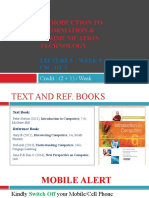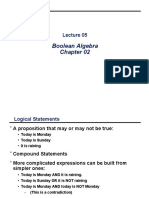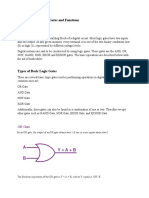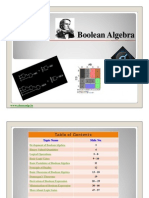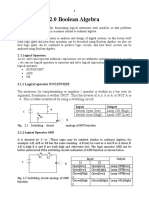0 ratings0% found this document useful (0 votes) 24 views10 pagesModule 3 Phoenix
This is a computer studies pdf for all student
Copyright
© © All Rights Reserved
We take content rights seriously. If you suspect this is your content,
claim it here.
Available Formats
Download as PDF or read online on Scribd
_ L
MODULE 3
Boolean Algebra, Fundamentals of Truth tables and Precedence
Algebra
Algebra means reunion on broken parts. It is the study of mathematical symbols and rul
es for manipulating the symbols. Algebra can be regarded as elementary, abstract or mo
dem depending on the level or field of study.
Algebra has computations similar to arithmetic but with letters standing for numbers whi
ch allows proofs of properties that are true regardless of the numbers involved. For exam
ple, quadratic equation: ax? + bx + = 0 where a, b, ccan be any number (a0). Algebra i
sused in many studies, for example, elementary algebra, linear algebra, Boolean algebra,
and so on.
1 Polynomials
‘Apolynomial involves operations of addition, subtraction, multiplication, and non-negati
ve integer exponents of terms consisting of variables and coefficients. For example, x¢ +
2x= 3 is a polynomial in the single variable x. Polynomial can be rewritten using commu
tative, associative and distributive laws.
‘An important part of algebra is the factorization of polynomials by expressing a given po
lynomial as a product of other polynomials that cannot be factored any further. Another i
mportant part of algebra is computation of polynomial greatest common divisors. x2 + 2
x= 3.can be factored as (x- 1)(x+3)
12 Boolean Algebra
Boolean algebra is the branch of algebra in which the values of the variables are true val
ues denoted by 1 and 0 or true and false respectively.
Boolean algebra can be used to describe logic circuit; itis also use to reduce complexity
of digital circuits by simplifying the logic circuits. Boolean algebra is also referred to as B
oolean logic. It was developed by George Boole sometime on the 1840s and is greatly us
ed in computations and in computer operations. The name Boolean comes from the na
me of the author
Boolean algebra is a logical calculus of truth values. It somewhat resembles the arithmet
“d rT�_ L
“]
ic algebra of real numbers but with a difference in its operators and operations. Boolean
operations involve the set {0, 1), that is, the numbers 0 and 1. Zero [0] represents “false” o
r “off” and One [1] represent
1 -Thue, on
0 - False, off
This has proved useful in programming computer devices, in the selection of actions bas
ed on conditions set.
Basic Boolean operations
1. AND
The AND operator is represented by a period or dot in-between the two operands e.
g
“XY
The Boolean multiplication operator is known as the AND function in the logic do
main; the function evaluates to 1 only if both the independent variables have thev
alue 1
2. OR
The OR operator is represented by an addition sign. Here the operation + is differe
nt from that defined in normal arithmetic algebra of numbers. E.g. X+Y
The # operator is known as the OR function in the logic domain; the function has
a value of 7 if either or both of the independent variables has the value of 1
3. NOT
The NOT operator is represented by X' or X.
This operator negates whatever value is contained in or assigned to X. It changes
its value to the opposite value. For instance, if the value contained in X is 1, X' giv
es 0 as the result and if the value stored in X is 0, X' gives 1 as the result. In some
texts, NOT may be represented as X
To better understand these operations, truth table is presented for the result of any of the
operations on any two variables.
-�_ L
Truth Tables
Atruth table is a mathematical table used in logic to compute the functional values of lo
gical expressions on each of their functional arguments. It is specifically in connection w
ith Boolean algebra and Boolean functions. Truth tables can be used to tell if a propositi
on expression is logically valid. In a truth table, the output is completely dependent on th
einput. Itis composed of a column for each input entry and another column the corresp
onding output. Each row of the truth table therefore contains one possible configuration
of the input variables (for instance, X=true Y=false), and the result of the operation for th
ose values
Applications of truth table
1. The truth table can be used in analyzing arguments
2. It is used to reduce basic Boolean operations in computing
3. It is used to test the validity of statements. In validating statements, the follow
ing three steps can be followed
a. Represent each premise (represented as inputs) with a symbol (a variable).
b. Represent the conclusion (represented as the final result) with a symbol (a vari
able)
©. Drawa truth table with columns for each premise (input) and a column for the
conclusion (result)
Truth tables are a means of representing the results of a logic function using a table. Th
ey are constructed by defining all possible combinations of the inputs to a function in th
e Boolean algebra, and then calculating the output for each combination in turn. The bas
ic truth table shows the various operators and the result of their operations involving two
variables only. More complex truth tables can be built from the knowledge of the foundat
ional truth table. The number of input combinations in a Boolean function is determined
by the number of variables in the function and this is computed using the formula 2”.
Number of input combinations =2". Where nis number of variable(s)
For example, a function with two variables has an input combination of 27=4, Another w
ith three variables has 2?=8 input combinations, and so on.
AND
“d rT�x [¥ [XY
NOT�‘The NOT operation is a unary operator, it accepts only one input.
Example:
Draw a truth table for A+B
BC_}ASBC *Draw a truth table for AB+BC.
AB [BC | AB+BC
=|=[=[=Jefefefe]>|a
a)alelel/a[alelole
=Jel=lel=le|=Telo
=)=]=]=Jolelolo|>
=|=}elel=|=\elele
alolalolsfolatolo
alelelo[slolelo
«Draw a truth table for A(B+
D).
A[B[D [B+D | A(B+D)
0 O}0j\0 0
oo o}j1 41 0
o41j011 0
oj j1jiii 0
1jololo /o
Tiojiii it
Tiijol i
tai
AB | ABC + ABC
c
ojo joj1 oi 1
ojo ji|1 ojo jo
oj1 jojijojijo jo fo�o{1 |i{1fofofo |{o fo
ilo jojo jaja it o fi
iio /1/ol1jolo jo fo
1|1 /olo joli1 lo jo fo
1{1 |i Jo jojojo jo fo
Basic Logic Gates
Logic can be viewed as black boxes with binary input (independent variable) and binary
output (dependent variable). It also refers to both the study of modes of reasoning and t
he use of valid reasoning. In the latter sense, logic is used in most intellectual activities
Logie in computer science has emerged as-a discipline and it has been extensively appli
edin the fields of Artificial Intelligence, and Computer Science, and these fields provide a
rich source of problems in formal and informal logic.
Boolean logic, which has been considered as a fundamental part to computer hardware,
particularly, the system's arithmetic and logic structures, relating to operators AND, NOT,
and OR,
Logic gates
Alogic gate is an elementary building block of a digital circuit. Complex electronic circuit
sare built using the basic logic gates. At any given moment, every terminal of the logic g
ate is in one of the two binary conditions low (0) of high (1), represented by different volt
age levels
There are 3 basic logic gates: AND, OR, NOT.
Other gates- NAND, NOR, XOR and XNOR are based on the3 basic gates.
‘The AND gate
The AND gate is so called because, if 0is called “false” and 1 is called "true! the gate act
sin the sameway as the logical ‘and” operator. The following illustration and table show
the circuit symbol and logic combinations for an AND gate
The output is “true when both inputs are "true." Otherwise, the output is “false.”�Louiclunctions = Z2AB
“rath Table:
The OR gate
The OR gate gets its name from the fact that it behaves after the way of the logical “or”
The output is "true’ if either or both of the inputs are "true." If both inputs are "false; then
the output is “false.”
amputs, gurput
a
z
B
Logie Function: = Z = A+B
‘nwh Table
Tnpuls—— Quiput
A B Zz
oo] 0
oo 1
104
1 1 1
The NOT gate
Alogical inverter, sometimes called a NOT gate to differentiate it from other types of elec
‘tronic inverter devices, has only one input. It reverses the logic state (i.e. its input).
“d rT�Input Duiput
a Zz
Logie Function: 7 =
Truth Table:
oput Output
AZ
0 1
1 0
As previously considered, the AND, OR and NOT gates’ actions correspond with the AND,
OR and NOT operators.
More complex functions can be constructed from the three basic gates by using DeMorg
ans Law.
‘The NAND gate
‘The NAND gate operates as an AND gate followed by a NOT gate. It acts in the manner 0
f the logical operation “and' followed by negation. The output is “false’ if both inputs are
“ue! Otherwise, the output is “true’. It finds the AND of two values and then finds the op
posite of the resulting value.
Loputs ouput
at
Zz
s—
TogieTuneton: 7 9B
tiuth abe:
Inputs Ouiput
A plz
oo) 1
oO 1 1
to 4
1 1 | 0�_ L
‘The NOR gate
‘The NOR gate is a combination of an OR gate fallowed by an inverter Its outputis "true"
if both inputs are false." Otherwise, the output is “false’. It finds the OR of two values an
d then finds the complement of the resulting value.
snp
a
B
lopietimeion: 7 = TaB
Truth Table:
Inputs Ourput
The XOR gate
The XOR (exclusive-OR) gate acts in the sameway as the logical “either/or The output i
s"true’ if either, but not both, of the inputs are "true." The output is ‘false’ if both inputs a
re “false or if both inputs are “true. Another way of looking at this circuit is to observe th
at the output is 1 if the inputs are different, but 0 if the inputs are the same.
=>) >, A @ B)
XOR gate
ABE
0 fo jo
of
0
h
The XNOR gate
‘The XNOR (exclusive-NOR) gate is a combination of an XOR gate followed by an inverter
“]
-�_ L
Its output is ‘true" ifthe inputs are the same, and'false' if the inputs are different. It perfo
rms the operation of an XOR gate and then inverts the resulting value.
XNOR gate








